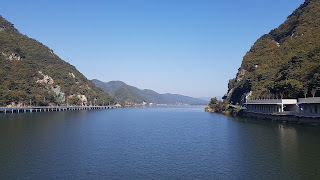Discovering the Best of Gwangyang: A Guide to South Jeolla Province's Hidden Gem in Korea
Exploring Gwangyang: A Hidden Gem of South Jeolla Province, Korea
Are you planning to visit Korea soon? Don't miss out on Gwangyang, a hidden gem of South Jeolla Province that boasts stunning natural landscapes, rich cultural heritage, and mouth-watering local cuisine. In this article, we will take you on a virtual tour of Gwangyang and introduce you to its top attractions, from traditional temples to modern museums, and everything in between.
Introduction to Gwangyang
Located in the southwestern part of Korea, Gwangyang is a city that is often overlooked by tourists in favor of more famous destinations like Seoul or Busan. However, Gwangyang has a lot to offer, and it's worth taking the time to explore this charming city. Gwangyang is known for its natural beauty, with mountains, rivers, and beaches all within easy reach. It's also a city with a rich cultural heritage, where you can learn about traditional Korean customs and experience local festivals and events.
Must-Visit Attractions in Gwangyang
Seomjin Village
Seomjin Village is a traditional Korean village located on the banks of the Seomjin River. This village has preserved the architecture and way of life of Korea's past, allowing visitors to step back in time and experience traditional Korean culture. The village is particularly famous for its thatched-roof houses, which have been designated as important cultural properties by the Korean government.
Hoedeok-haean Provincial Park
Hoedeok-haean Provincial Park is a stunning natural park that spans over 130 square kilometers. The park is home to a variety of flora and fauna, including endangered species like the Korean goral and the otter. Visitors can hike along the park's many trails, fish in the crystal-clear streams, and enjoy breathtaking views of the surrounding mountains.
Gwangyang Maehwa Village
Gwangyang Maehwa Village is a picturesque village that is famous for its plum blossoms. Every year in March, the village hosts the Gwangyang Maehwa Festival, which attracts thousands of visitors from all over Korea. During the festival, the village is transformed into a sea of pink and white blossoms, and visitors can enjoy a range of cultural events and performances.
Muan MBC Drama Center
Muan MBC Drama Center is a must-visit destination for K-drama fans. The center is home to a variety of sets and props from popular Korean dramas like "The Moon Embracing the Sun" and "Gu Family Book." Visitors can take a tour of the center and even dress up in traditional Korean costumes for a photo shoot.
Yeosu
Yeosu is a neighboring city to Gwangyang that is famous for its scenic beauty. Visitors can take a cable car to the top of Mt. Jebul, which offers breathtaking views of the surrounding sea and islands. Yeosu is also home to the Yeosu Expo, a world-class event that showcases the latest in marine technology and culture.
Local Cuisine
Gwangyang Charcoal Bulgogi
This local specialty features tender slices of beef marinated in a special sauce made with soy sauce, garlic, and sesame oil, and then grilled over charcoal for a smoky flavor.
Gwangyang Baegunsan Ancient Tombs
These ancient tombs are over 1,500 years old and are a testament to Gwangyang's rich cultural heritage. Visitors can learn about the tombs' history and significance and enjoy the beautiful natural scenery that surrounds them.
Gwangyang Seomjingang Shellfish
The Seomjingang River is famous for its shellfish, which are harvested daily and sold at the Seomjingang Shellfish Market. Visitors can enjoy a variety of shellfish dishes, including grilled clams, stir-fried oysters, and spicy squid.
Mangdeok Port Autumn Gizzard
This local delicacy is made with the gizzards of a type of sea squirt that is only available in the fall. The gizzards are cleaned and seasoned with soy sauce, garlic, and other spices and then grilled until crispy and tender.
Conclusion
Gwangyang may not be as well-known as some of Korea's other cities, but it's definitely worth a visit. Whether you're interested in nature, culture, or food, Gwangyang has something to offer. So why not add Gwangyang to your Korean itinerary and experience the hidden beauty of this charming city.
FAQs
- How do I get to Gwangyang?
Gwangyang is easily accessible by train or bus from major cities like Seoul or Busan. You can also fly into Gwangju Airport and take a taxi or bus to Gwangyang. - When is the best time to visit Gwangyang?
The best time to visit Gwangyang is in the spring or fall when the weather is mild and the scenery is at its most beautiful. - What is the local currency in Gwangyang?
The local currency in Gwangyang, as in the rest of Korea, is the Korean won. - Are there any traditional Korean markets in Gwangyang?
Yes, Gwangyang has several traditional markets where you can buy local products and sample traditional Korean food. - Is English widely spoken in Gwangyang?
While English is not as widely spoken in Gwangyang as in larger cities like Seoul or Busan, many locals are friendly and willing to help visitors. It's always a good idea to learn a few basic Korean phrases before your trip.


댓글
댓글 쓰기